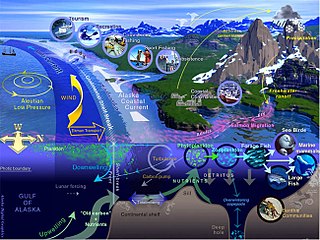 W
WMarine life, or sea life or ocean life, is the plants, animals and other organisms that live in the salt water of the sea or ocean, or the brackish water of coastal estuaries. At a fundamental level, marine life affects the nature of the planet. Marine organisms, mostly microorganisms, produce oxygen and sequester carbon. Shorelines are in part shaped and protected by marine life, and some marine organisms even help create new land. The term marine comes from the Latin mare, meaning sea or ocean.
 W
WMarine primary production is the chemical synthesis in the ocean of organic compounds from atmospheric or dissolved carbon dioxide. It principally occurs through the process of photosynthesis, which uses light as its source of energy, but it also occurs through chemosynthesis, which uses the oxidation or reduction of inorganic chemical compounds as its source of energy. Almost all life on Earth relies directly or indirectly on primary production. The organisms responsible for primary production are called primary producers or autotrophs.
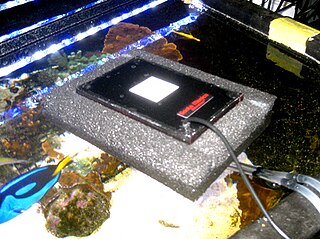 W
WAn algae scrubber is a water filtering device which uses light to grow algae; in this process, undesirable chemicals are removed from the water. Algae scrubbers allow saltwater, freshwater and pond hobbyists to operate their tanks using natural filtration in the form of primary production, much like oceans and lakes.
 W
WAn algal bloom or algae bloom is a rapid increase or accumulation in the population of algae in freshwater or marine water systems, and is often recognized by the discoloration in the water from their pigments. The term algae encompasses many types of aquatic photosynthetic organisms, both macroscopic, multicellular organisms like seaweed and microscopic, unicellular organisms like cyanobacteria. Algal bloom commonly refers to rapid growth of microscopic, unicellular algae, not macroscopic algae. An example of a macroscopic algal bloom is a kelp forest.
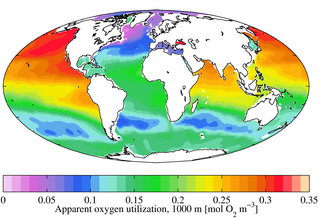 W
WIn freshwater or marine systems apparent oxygen utilization (AOU) is the difference between oxygen gas solubility and the measured oxygen concentration in water with the same physical and chemical properties. Such differences typically occur when biological activity acts to change the ambient concentration of oxygen. For example, primary production liberates oxygen and increases its concentration, while respiration consumes it and decreases its concentration.
 W
WBacterioplankton refers to the bacterial component of the plankton that drifts in the water column. The name comes from the Ancient Greek word πλανκτος, meaning "wanderer" or "drifter", and bacterium, a Latin term coined in the 19th century by Christian Gottfried Ehrenberg. They are found in both seawater and freshwater.
 W
WThe biological pump, also known as the marine carbon pump, is, in its simplest form, the ocean's biologically driven sequestration of carbon from the atmosphere and land runoff to the ocean interior and seafloor sediments. It is the part of the oceanic carbon cycle responsible for the cycling of organic matter formed mainly by phytoplankton during photosynthesis (soft-tissue pump), as well as the cycling of calcium carbonate (CaCO3) formed into shells by certain organisms such as plankton and mollusks (carbonate pump).
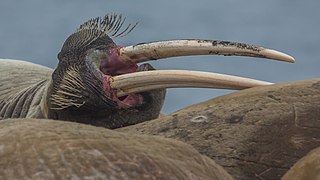 W
WBioturbation is defined as the reworking of soils and sediments by animals or plants. These include burrowing, ingestion, and defecation of sediment grains. Bioturbating activities have a profound effect on the environment and are thought to be a primary driver of biodiversity. The formal study of bioturbation began in the 1800s by Charles Darwin experimenting in his garden. The disruption of aquatic sediments and terrestrial soils through bioturbating activities provides significant ecosystem services. These include the alteration of nutrients in aquatic sediment and overlying water, shelter to other species in the form of burrows in terrestrial and water ecosystems, and soil production on land.
 W
WBlue carbon refers to carbon dioxide removed from the atmosphere by the world's coastal ocean ecosystems, mostly mangroves, salt marshes, seagrasses and macroalgae, through plant growth and the accumulation and burial of organic matter in the soil.
 W
WThe brown algae, comprising the class Phaeophyceae, are a large group of multicellular algae, including many seaweeds located in colder waters within the Northern Hemisphere. Most brown algae live in marine environments, where they play an important role both as food and as a potential habitat. For instance, Macrocystis, a kelp of the order Laminariales, may reach 60 m (200 ft) in length and forms prominent underwater kelp forests. Kelp forests like these contain a high level of biodiversity. Another example is Sargassum, which creates unique floating mats of seaweed in the tropical waters of the Sargasso Sea that serve as the habitats for many species. Many brown algae, such as members of the order Fucales, commonly grow along rocky seashores. Some members of the class, such as kelps, are used by humans as food.
 W
WIn oceanic biogeochemistry, the continental shelf pump is proposed to operate in the shallow waters of the continental shelves, acting as a mechanism to transport carbon from surface waters to the interior of the adjacent deep ocean.
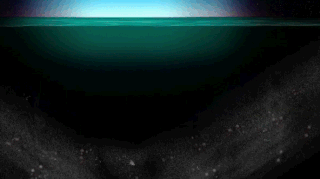 W
WDiel vertical migration (DVM), also known as diurnal vertical migration, is a pattern of movement used by some organisms, such as copepods, living in the ocean and in lakes. The migration occurs when organisms move up to the uppermost layer of the sea at night and return to the bottom of the daylight zone of the oceans or to the dense, bottom layer of lakes during the day. The word diel comes from the Latin dies day, and means a 24-hour period. In terms of biomass, it is the greatest migration in the world. It is not restricted to any one taxon as examples are known from crustaceans (copepods), molluscs (squid), and ray-finned fishes (trout). Various stimuli are responsible for this phenomenon, the most prominent being response to changes in light intensity, though evidence suggests that biological clocks are an underlying stimulus as well. The phenomenon may arise for a number of reasons, though it is most typically to access food and avoid predators. While this mass migration is generally nocturnal, with the animals ascending from the depths at nightfall and descending at sunrise, the timing can be altered in response to the different cues and stimuli that trigger it. Some unusual events impact vertical migration: DVM is absent during the midnight sun in Arctic regions and vertical migration can occur suddenly during a solar eclipse.
 W
WThe Discovery Investigations were a series of scientific cruises and shore-based investigations into the biology of whales in the Southern Ocean. They were funded by the British Colonial Office and organised by the Discovery Committee in London, which was formed in 1918. They were intended to provide the scientific background to stock management of the commercial Antarctic whale fishery.
 W
WIn oceanic biogeochemistry, the f-ratio is the fraction of total primary production fuelled by nitrate. The ratio was originally defined by Richard Eppley and Bruce Peterson in one of the first papers estimating global oceanic production. This fraction was originally believed significant because it appeared to directly relate to the sinking (export) flux of organic marine snow from the surface ocean by the biological pump. However, this interpretation relied on the assumption of a strong depth-partitioning of a parallel process, nitrification, that more recent measurements has questioned.
 W
WFish reproductive organs include testes and ovaries. In most species, gonads are paired organs of similar size, which can be partially or totally fused. There may also be a range of secondary organs that increase reproductive fitness. The genital papilla is a small, fleshy tube behind the anus in some fishes, from which the sperm or eggs are released; the sex of a fish often can be determined by the shape of its papilla.
 W
WGelatinous zooplankton are fragile animals that live in the water column in the ocean. Their delicate bodies have no hard parts and are easily damaged or destroyed. Gelatinous zooplankton are often transparent. All jellyfish are gelatinous zooplankton, but not all gelatinous zooplankton are jellyfish. The most commonly encountered organisms include ctenophores, medusae, salps, and Chaetognatha in coastal waters. However, almost all marine phyla, including Annelida, Mollusca and Arthropoda, contain gelatinous species, but many of those odd species live in the open ocean and the deep sea and are less available to the casual ocean observer. Many gelatinous plankters utilize mucous structures in order to filter feed. Gelatinous zooplankton have also been called "Gelata".
 W
WA harmful algal bloom (HAB) contains organisms that can severely lower oxygen levels in natural waters, killing marine life. Some HABs are associated with algae-produced toxins. Blooms can last from a few days to many months. After the bloom dies, the microbes which decompose the dead algae use up even more of the oxygen, which can create fish die-offs. When these zones of depleted oxygen cover a large area for an extended period of time, they are referred to as dead zones, where neither fish nor plants are able to survive.
 W
WIchthyoplankton are the eggs and larvae of fish. They are mostly found in the sunlit zone of the water column, less than 200 metres deep, which is sometimes called the epipelagic or photic zone. Ichthyoplankton are planktonic, meaning they cannot swim effectively under their own power, but must drift with the ocean currents. Fish eggs cannot swim at all, and are unambiguously planktonic. Early stage larvae swim poorly, but later stage larvae swim better and cease to be planktonic as they grow into juveniles. Fish larvae are part of the zooplankton that eat smaller plankton, while fish eggs carry their own food supply. Both eggs and larvae are themselves eaten by larger animals.
 W
WJelly-falls are marine carbon cycling events whereby gelatinous zooplankton, primarily cnidarians, sink to the seafloor and enhance carbon and nitrogen fluxes via rapidly sinking particulate organic matter. These events provide nutrition to benthic megafauna and bacteria. Jelly-falls have been implicated as a major “gelatinous pathway” for the sequestration of labile biogenic carbon through the biological pump. These events are common in protected areas with high levels of primary production and water quality suitable to support cnidarian species. These areas include estuaries and several studies have been conducted in fjords of Norway.
 W
WMarine biology is the scientific study of marine life, organisms in the sea. Given that in biology many phyla, families and genera have some species that live in the sea and others that live on land, marine biology classifies species based on the environment rather than on taxonomy.
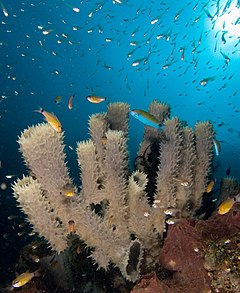 W
WMarine habitats are habitats that support marine life. Marine life depends in some way on the saltwater that is in the sea. A habitat is an ecological or environmental area inhabited by one or more living species. The marine environment supports many kinds of these habitats.
 W
WMarine ecosystems are the largest of Earth's aquatic ecosystems and are distinguished by waters that have a high salt content. These systems contrast with freshwater ecosystems, which have a lower salt content. Marine waters cover more than 70% of the surface of the Earth and account for more than 97% of Earth's water supply and 90% of habitable space on Earth. Marine ecosystems include nearshore systems, such as the salt marshes, mudflats, seagrass meadows, mangroves, rocky intertidal systems and coral reefs. They also extend outwards from the coast to include offshore systems, such as the surface ocean, pelagic ocean waters, the deep sea, oceanic hydrothermal vents, and the sea floor. Marine ecosystems are characterized by the biological community of organisms that they are associated with and their physical environment.
 W
WMarine microorganisms are defined by their habitat as the microorganisms living in a marine environment, that is, in the saltwater of a sea or ocean or the brackish water of a coastal estuary. A microorganism is any microscopic living organism, that is, any life form too small for the naked human eye to really see, needing a microscope. Microorganisms are very diverse. They can be single-celled or multicellular and include all bacteria and archaea and most protozoa, as well as some species of fungi, algae, and certain microscopic animals, such as rotifers and copepods. Many macroscopic animals and plants have microscopic juvenile stages. Some microbiologists also classify biologically active entities such as viruses and viroids as microorganisms, but others consider these as non-living.
 W
WMarine prokaryotes are marine bacteria and marine archaea. They are defined by their habitat as prokaryotes that live in marine environments, that is, in the saltwater of seas or oceans or the brackish water of coastal estuaries. All cellular life forms can be divided into prokaryotes and eukaryotes. Eukaryotes are organisms whose cells have a nucleus enclosed within membranes, whereas prokaryotes are the organisms that do not have a nucleus enclosed within a membrane. The three-domain system of classifying life adds another division: the prokaryotes are divided into two domains of life, the microscopic bacteria and the microscopic archaea, while everything else, the eukaryotes, become the third domain.
 W
WMarine protists are defined by their habitat as protists that live in marine environments, that is, in the saltwater of seas or oceans or the brackish water of coastal estuaries. Life originated as single-celled prokaryotes and later evolved into more complex eukaryotes. Eukaryotes are the more developed life forms known as plants, animals, fungi and protists. Protists are the eukaryotes that cannot be classified as plants, fungi or animals. They are usually single-celled and microscopic. The term protist came into use historically as a term of convenience for eukaryotes that cannot be strictly classified as plants, animals or fungi. They are not a part of modern cladistics, because they are paraphyletic.
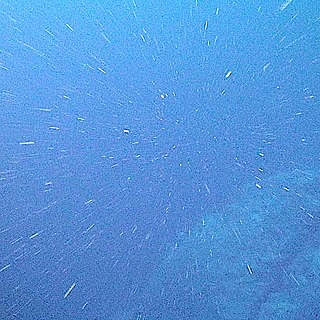 W
WIn the deep ocean, marine snow is a continuous shower of mostly organic detritus falling from the upper layers of the water column. It is a significant means of exporting energy from the light-rich photic zone to the aphotic zone below which is referred to as the biological pump. Export production is the amount of organic matter produced in the ocean by primary production that is not recycled (remineralised) before it sinks into the aphotic zone. Because of the role of export production in the ocean's biological pump, it is typically measured in units of carbon .The term was first coined by the explorer William Beebe as he observed it from his bathysphere. As the origin of marine snow lies in activities within the productive photic zone, the prevalence of marine snow changes with seasonal fluctuations in photosynthetic activity and ocean currents. Marine snow can be an important food source for organisms living in the aphotic zone, particularly for organisms which live very deep in the water column.
 W
WMarine vertebrates are vertebrates that live in marine environments. These are the marine fish and the marine tetrapods. Vertebrates are a subphylum of chordates that have a vertebral column (backbone). The vertebral column provides the central support structure for an internal skeleton. The internal skeleton gives shape, support, and protection to the body and can provide a means of anchoring fins or limbs to the body. The vertebral column also serves to house and protect the spinal cord that lies within the column.
 W
WMarine viruses are defined by their habitat as viruses that are found in marine environments, that is, in the saltwater of seas or oceans or the brackish water of coastal estuaries. Viruses are small infectious agents that can only replicate inside the living cells of a host organism, because they need the replication machinery of the host to do so. They can infect all types of life forms, from animals and plants to microorganisms, including bacteria and archaea.
 W
WMicroalgae or microphytes are microscopic algae, typically found in freshwater and marine systems, living in both the water column and sediment. They are unicellular species which exist individually, or in chains or groups. Depending on the species, their sizes can range from a few micrometers (μm) to a few hundred micrometers. Unlike higher plants, microalgae do not have roots, stems, or leaves. They are specially adapted to an environment dominated by viscous forces. Microalgae, capable of performing photosynthesis, are important for life on earth; they produce approximately half of the atmospheric oxygen and use simultaneously the greenhouse gas carbon dioxide to grow photoautotrophically. Microalgae, together with bacteria, form the base of the food web and provide energy for all the trophic levels above them. Microalgae biomass is often measured with chlorophyll a concentrations and can provide a useful index of potential production.
 W
WMilky seas, also called mareel, is a luminous phenomenon in the ocean in which large areas of seawater appear to glow translucently. The phenomenon glow brightly enough at night to be seen by satellites orbiting Earth.
 W
WMycoplankton are saprotropic members of the plankton communities of marine and freshwater ecosystems. They are composed of filamentous free-living fungi and yeasts that are associated with planktonic particles or phytoplankton. Similar to bacterioplankton, these aquatic fungi play a significant role in heterotrophic mineralization and nutrient cycling. Mycoplankton can be up to 20 mm in diameter and over 50 mm in length.
 W
WOcean acidification is the ongoing decrease in the pH of the Earth's oceans, caused by the uptake of carbon dioxide (CO2) from the atmosphere. The main cause of ocean acidification is the burning of fossil fuels. Seawater is slightly basic (meaning pH > 7), and ocean acidification involves a shift towards pH-neutral conditions rather than a transition to acidic conditions (pH < 7). The issue of ocean acidification is the decreased production of the shells of shellfish and other aquatic life with calcium carbonate shells. The calcium carbonate shells can not reproduce under high saturated acidotic waters. An estimated 30–40% of the carbon dioxide from human activity released into the atmosphere dissolves into oceans, rivers and lakes. Some of it reacts with the water to form carbonic acid. Some of the resulting carbonic acid molecules dissociate into a bicarbonate ion and a hydrogen ion, thus increasing ocean acidity (H+ ion concentration). Between 1751 and 1996, surface ocean pH is estimated to have decreased from approximately 8.25 to 8.14, representing an increase of almost 30% in H+ ion concentration in the world's oceans. Earth System Models project that, by around 2008, ocean acidity exceeded historical analogues and, in combination with other ocean biogeochemical changes, could undermine the functioning of marine ecosystems and disrupt the provision of many goods and services associated with the ocean beginning as early as 2100.
 W
WOcean acidification threatens the Great Barrier Reef by reducing the viability and strength of coral reefs. The Great Barrier Reef, considered one of the seven natural wonders of the world and a biodiversity hotspot, is located in Australia. Similar to other coral reefs, it is experiencing degradation due to ocean acidification. Ocean acidification results from a rise in atmospheric carbon dioxide, which is taken up by the ocean. This process can increase sea surface temperature, decrease aragonite, and lower the pH of the ocean.
 W
WThe oxygen minimum zone (OMZ), sometimes referred to as the shadow zone, is the zone in which oxygen saturation in seawater in the ocean is at its lowest. This zone occurs at depths of about 200 to 1,500 m (660–4,920 ft), depending on local circumstances. OMZs are found worldwide, typically along the western coast of continents, in areas where an interplay of physical and biological processes concurrently lower the oxygen concentration and restrict the water from mixing with surrounding waters, creating a “pool” of water where oxygen concentrations fall from the normal range of 4–6 mg/l to below 2 mg/l.
 W
WIn aquatic biology, the paradox of the plankton describes the situation in which a limited range of resources supports an unexpectedly wide range of plankton species, apparently flouting the competitive exclusion principle which holds that when two species compete for the same resource, one will be driven to extinction.
 W
WThe order Pennales is a traditional subdivision of the heterokont algae known as diatoms. The order is named for the shape of the cell walls of pennate diatoms, which are elongated in valve view. The valves may be linear or oval in shape, and usually bear bilaterally symmetrical ornamental patterns. These patterns are composed of a series of transverse lines that can appear as rows of dots when viewed with an optical microscope. Some pennate diatoms also exhibit a fissure along their longitudinal axis. This is known as a raphe, and is involved in gliding movements made by diatom cells; motile diatoms always possess a raphe.
 W
WPhotosynthetic picoplankton or picophytoplankton is the fraction of the phytoplankton performing photosynthesis composed by cells between 0.2 and 2 µm (picoplankton). It is especially important in the central oligotrophic regions of the world oceans that have very low concentration of nutrients.
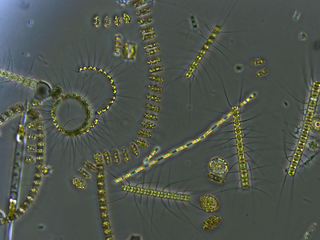 W
WPhytoplankton are the autotrophic (self-feeding) components of the plankton community and a key part of ocean and freshwater ecosystems. The name comes from the Greek words φυτόν (phyton), meaning "plant", and πλαγκτός (planktos), meaning "wanderer" or "drifter".
 W
WPicoeukaryotes are picoplanktonic eukaryotic organisms 3.0 µm or less in size. They are distributed throughout the world’s marine and freshwater ecosystems and constitute a significant contribution to autotrophic communities. Though the SI prefix pico- might imply an organism smaller than atomic size, the term was likely used to avoid confusion with existing size classifications of plankton.
 W
WPicoplankton is the fraction of plankton composed by cells between 0.2 and 2 μm that can be either prokaryotic and eukaryotic phototrophs and heterotrophs:photosynthetic heterotrophic
 W
WPlankton are the diverse collection of organisms found in water that are unable to propel themselves against a current. The individual organisms constituting plankton are called plankters. In the ocean, they provide a crucial source of food to many small and large aquatic organisms, such as bivalves, fish and whales.
 W
WPolar seas is a collective term for the Arctic Ocean and the southern part of the Southern Ocean. In the coldest years, sea ice can cover around 13 percent of the Earth's total surface at its maximum, but out of phase in the two hemispheres. The polar seas contain a huge biome with many organisms.
 W
WProject Kaisei is a scientific and commercial mission to study and clean up the Great Pacific Garbage Patch, a large body of floating debris trapped in the Pacific Ocean by the currents of the North Pacific Gyre. Discovered by NOAA, the patch is estimated to contain 20 times the density of floating debris compared to the global average. The project aims to study the extent and nature of the debris with a view to capturing, detoxifying, and recycling the material, and is organised by the Ocean Voyages Institute, a California-based 501c3 non-profit organisation dealing with marine preservation. The project is based in San Francisco and Hong Kong.
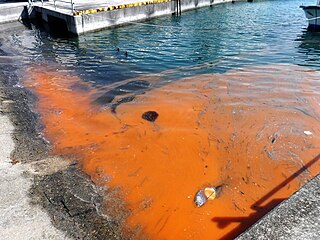 W
WRed tide is a common name for algal blooms, which are large concentrations of aquatic microorganisms, such as protozoans and unicellular algae. The upwelling of nutrients from the sea floor, often following massive storms, provides for the algae and triggers bloom events. Harmful algal blooms can occur worldwide, and natural cycles can vary regionally.
 W
WThe National Science Foundation's (NSF) Ocean Observatories Initiative (OOI) Regional Scale Nodes (RSN) component is an electro-optically cabled underwater observatory that directly connects to the global Internet. It is the largest cable-linked seabed observatory in the world, and also the first of its kind in the United States.
 W
WSea snot or marine mucilage is a collection of mucus-like organic matter found in the sea. The substance is described as "jello-like sheets of disease-carrying mucus" that holds a strong presence in the Mediterranean Sea and has been spreading into farther-flung waters.
 W
WThin layers are concentrated aggregations of phytoplankton and zooplankton in coastal and offshore waters that are vertically compressed to thicknesses ranging from several centimeters up to a few meters and are horizontally extensive, sometimes for kilometers. Generally, thin layers have three basic criteria: 1) they must be horizontally and temporally persistent; 2) they must not exceed a critical threshold of vertical thickness; and 3) they must exceed a critical threshold of maximum concentration. The precise values for critical thresholds of thin layers has been debated for a long time due to the vast diversity of plankton, instrumentation, and environmental conditions. Thin layers have distinct biological, chemical, optical, and acoustical signatures which are difficult to measure with traditional sampling techniques such as nets and bottles. However, there has been a surge in studies of thin layers within the past two decades due to major advances in technology and instrumentation. Phytoplankton are often measured by optical instruments that can detect fluorescence such as LIDAR, and zooplankton are often measured by acoustic instruments that can detect acoustic backscattering such as ABS. These extraordinary concentrations of plankton have important implications for many aspects of marine ecology, as well as for ocean optics and acoustics. It is important to note that zooplankton thin layers are often found slightly under phytoplankton layers because many feed on them. Thin layers occur in a wide variety of ocean environments, including estuaries, coastal shelves, fjords, bays, and the open ocean, and they are often associated with some form of vertical structure in the water column, such as pycnoclines, and in zones of reduced flow.
 W
WThe Van Veen grab sampler is an instrument to sample sediment in water environments. Usually it is a clamshell bucket made of stainless steel. Up to 20 cm deep samples of roughly 0.1 m2 can be extracted with this instrument. It can be light-weight and low-tech. The smallest version even fits into hand luggage. The sampler was invented by Johan van Veen in 1933.
 W
WWhale feces, the excrement of whales, has a significant role in the ecology of the oceans, and whales have been referred to as "marine ecosystem engineers". Nitrogen released by cetacean species and iron chelate is a significant benefit to the marine food chain in addition to sequestering carbon for long periods. Whale feces can give information on a number of aspects of the health, natural history and ecology of an animal or group as it contains DNA, hormones, toxins and other chemicals.
 W
WThe Young grab, or the Young modified Van Veen grab sampler is an instrument to sample sediment in the ocean. It is a modified version of the Van Veen grab sampler, with a clamshell bucket made out of stainless steel mounted to a supporting frame. The sampling area extracted with this instrument can vary depending on its size. With the modifications this version of the Van Veen grab sampler is heavier than the traditional version. The frame allows for better stability and level sampling. Weights can be attached to the frame to ensure the bucket grabs sufficient sediment, or skids to ensure the gear does not sink too deep in soft sediments.
 W
WZooplankton are heterotrophic plankton. Plankton are organisms drifting in oceans, seas, and bodies of fresh water. The word zooplankton is derived from the Greek zoon (ζῴον), meaning "animal", and planktos (πλαγκτός), meaning "wanderer" or "drifter". Individual zooplankton are usually microscopic, but some are larger and visible to the naked eye.